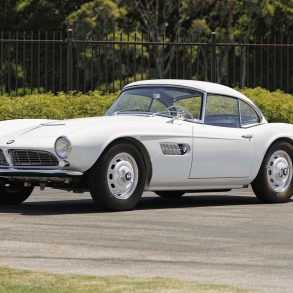The motor racing world was saddened to learn of the passing of Tom Walkinshaw in December of last year.
Tom Walkinshaw was the son of a successful market gardener at Mauldslie Farm, near Penicuik, Midlothian, Scotland. His initial days as a racing driver were a true test of grit and determination. Although he worked for the family business there was no quarter or favors given to him. He would drive from Scotland to race circuits in England on weekends, but had to be back and ready for work early Monday morning—no excuses. It was this upbringing that obviously moulded his character—a very no-nonsense man. His rise to fame was relatively quick, becoming Scottish Formula Ford champion in just his second season of racing with a Hawke, and he then campaigned the ex-Emerson Fittipaldi Lotus 59 in the British Formula Three Championship.
His single-seater driving career was a little curtailed in 1973 owing to the fuel crisis, and this coincided with him accepting an offer from Ford to drive and prepare their Escorts. His success with Ford was the springboard to what was to become Tom Walkinshaw Racing (TWR), and would lead to further successes with BMW, Mazda and Rover. Achievements with the latter became the prelude to a meeting with John Egan who asked if TWR could work on a Jaguar project, which would ultimately take them to victories at the 1988 and 1990 24 Hours of Le Mans. These victories took Jaguar back to the top of motor racing and, much more importantly for Egan, made it a headline brand for the British car industry.
Long distance sportscar racing was always known as a marathon rather than a sprint. Tom Walkinshaw was to change all that. I was privileged to have interviewed him last year, possibly the last one he ever gave, he said, “My, and indeed TWR’s, philosophy was always to build racing cars for racing drivers to drive. So, you have to build a car well enough for a driver to drive comfortably and drive the thing flat out. Some say endurance racing is like a marathon, pace yourself and it’ll all come good in the end. I don’t believe in that concept at all. My drivers needed a car to drive flat out from flag to flag—that’s racing!” Indeed, he brought F1 technology to sportscar racing too, initially harnessing the services of Tony Southgate and, later, Ross Brawn. Southgate was given the task of starting from a blank sheet of paper, from which he designed the triumphant XJR cars. His first, the XJR6, showed signs of what was to come, leading the opening laps of its first race.
Victory abounded not only in sportscars, but touring cars too. TWR teams and drivers have conquered in the British Touring Car Championship, the European Touring Car Championship and the V8 Super Cars in Australia. Over the last 18 months, or so, I’ve been able to speak to many former TWR drivers—Martin Brundle, Derek Warwick, Eddie Cheever, Andy Wallace, David Brabham, Win Percy, Jan Lammers, Patrick Tambay, John Watson, and Hans Heyer—to name but a few. They were unanimous in one thing; they all felt Tom Walkinshaw was a great man to drive for, a great motivator, and great team manager.
Ultimately, Formula One beckoned with Benetton in 1991, Tom was instrumental in them signing Michael Schumacher who won the 1994 and 1995 World Championships for them. After Benetton he took a 50 percent stake in Ligier, and then in 1997 took control of Arrows—notably signing the then current World Champion, Damon Hill, as his lead driver. In 1997, Hill was nearly able to give the team its first Grand Prix win, at Hungary, until a hydraulic problem intervened. On reflection, the Arrows move was to prove to be his demise, and in 2002 the Arrows and TWR teams went into liquidation.
It has to be said, controversy was never too far from Tom Walkinshaw’s door, with particular episodes at the British Racing Drivers Club and the aforementioned Arrows team. However, one thing is for sure, Tom Walkinshaw loved motor racing, both being successful and having fun. I go back to my interview with him. I asked about racing the Volvo Estate, his answer epitomized his personality, “I thought the estate car would mark their arrival more than their saloon car, and initially we’d have a lot more fun with it. We even put an inflatable dog in the back of it at one meeting. You see, that’s what it’s all about, you’re there to race, you’re there to be professional, but, you’ve got to enjoy yourself and have a bit of fun, too!”
It’s very difficult in these few lines to fully acknowledge and appreciate Tom Walkinshaw’s footprint on motor sport, both as a driver or as a team owner, but many have him to thank for their own personal success. On behalf of Vintage Racecar we offer our sincere condolences to his family and friends.
By Mike Jiggle










